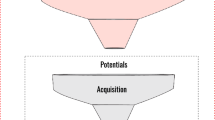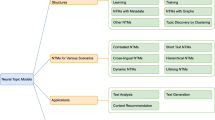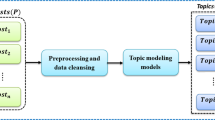Abstract
As an emerging online interaction service in Twitter-like social media systems, mention serves to significantly improve both user interaction experience and information propagation. In recent years, the problem of mentionee recommendation, i.e., recommending mentionees (mentioned users) when mentioners (mentioning users) mention others, has received considerable attention. However, the extreme sparsity of mentioner-mentionee matrix creates a severe challenge. While an increasing line of work has exploited diverse effects such as the textual content and spatio-temporal context influences to cope with this challenge, there lacks a comprehensive study of the joint effect of all these influencing factors. In light of this, we propose a joint latent-class probabilistic model, named Joint Topic-Area Model (JTAM), to tackle the mentionee recommendation problem by simultaneously learning and modeling users’ semantic interests, the spatio-temporal mentioning patterns of mentioners, the geographical distribution of mentionees, and their joint effects on users’ mention behaviors in a unified way. Moreover, to facilitate online query performance, we design an efficient query answering approach that enables fast top-k mentionee recommendation. To evaluate the performance of our method, we conduct extensive experiments on a large real-world dataset. The results demonstrate the superiority of our method in recommending mentionees in terms of both effectiveness and efficiency compared with other state-of-the-art methods.




Similar content being viewed by others
Notes
For clarity, we use the terms “mentioner” and “mentionee” to denote the mentioning and mentioned user, respectively.
References
Bobadilla J, Ortega F, Hernando A, Gutiérrez A (2013) Recommender systems survey. Knowledge-Based Systems 46:109–132
Chen J, Liu Y, Zou M (2017) User emotion for modeling retweeting behaviors. Neural Netw 96:11–21
Chen K, Chen T, Zheng G, Jin O, Yao E, Yu Y (2012) Collaborative personalized tweet recommendation. In: Proceedings of the 35th International ACM SIGIR Conference on Research and Development in Information Retrieval, ACM, pp 661–670
Cheng Z, Caverlee J, Barthwal H, Bachani V (2014) Who is the barbecue king of texas?: a geo-spatial approach to finding local experts on twitter. In: Proceedings of the 37th International ACM SIGIR Conference on Research & Development in Information Retrieval, ACM, pp 335–344
Compton R, Jurgens D, Allen D (2014) Geotagging one hundred million twitter accounts with total variation minimization. In: 2014 IEEE International Conference on Big Data (big data), IEEE, pp 393–401
Davoodi E, Kianmehr K, Afsharchi M (2013) A semantic social network-based expert recommender system. Appl Intell 39(1):1–13
Ding Z, Qiu X, Zhang Q, Huang X (2013) Learning topical translation model for microblog hashtag suggestion. In: IJCAI, pp 2078–2084
Ebner M, Holzinger A, Maurer H (2007) Web 2.0 technology: future interfaces for technology enhanced learning?. In: International Conference on Universal Access in Human-computer Interaction, Springer, pp 559–568
Gong Y, Zhang Q, Sun X, Huang X (2015) Who will you@?. In: Proceedings of the 24th ACM International on Conference on Information and Knowledge Management, ACM, pp 533–542
Griffiths TL, Steyvers M (2004) Finding scientific topics. Proc Natl Acad Sci 101(suppl 1):5228–5235
Gu S, Chen L, Li B, Liu W, Chen B (2019) Link prediction on signed social networks based on latent space mapping. Appl Intell 49(2):703–722
Gupta P, Goel A, Lin J, Sharma A, Wang D, Zadeh R (2013) Wtf: The who to follow service at twitter. In: Proceedings of the 22nd International Conference on World Wide Web, ACM, pp 505–514
Hiemstra D (2000) A probabilistic justification for using tf× idf term weighting in information retrieval. Int J Digit Libr 3(2):131–139
Huang H, Zhang Q, Huang X (2017) Mention recommendation for twitter with end-to-end memory network. In: Proceedings of the Twenty-Sixth International Joint Conference on Artificial Intelligence, IJCAI 2017, Melbourne, Australia, August 19-25, 2017, pp 1872–1878
Jiang B, Sha Y, Wang L (2015) Predicting user mention behavior in social networks. In: Natural Language Processing and Chinese Computing, Springer, pp 146–158
Kogan M, Palen L, Anderson KM (2015) Think local, retweet global: Retweeting by the geographically-vulnerable during hurricane sandy. In: Proceedings of the 18th ACM Conference on Computer Supported Cooperative Work & Social Computing, ACM, pp 981–993
Lee K, Mahmud J, Chen J, Zhou M, Nichols J (2014) Who will retweet this?: Automatically identifying and engaging strangers on twitter to spread information. In: Proceedings of the 19th International Conference on Intelligent User Interfaces, ACM, pp 247–256
Li Q, Song D, Liao L, Liu L (2015) Personalized mention probabilistic ranking–recommendation on mention behavior of heterogeneous social network. In: International Conference on Web-age Information Management, Springer, pp 41–52
Li R, Wang S, Deng H, Wang R, Chang KCC (2012) Towards social user profiling: unified and discriminative influence model for inferring home locations. In: Proceedings of the 18th ACM SIGKDD international conference on Knowledge discovery and data mining, pp. 1023–1031. ACM
Li Y, Ding Z, Zhang X, Liu B, Zhang W (2016) Confirmatory analysis on influencing factors when mention users in twitter. In: Asia-pacific Web Conference, Springer, pp 112–121
Lichman M, Smyth P (2014) Modeling human location data with mixtures of kernel densities. In: Proceedings of the 20th ACM SIGKDD International Conference on Knowledge Discovery and Data Mining, ACM, pp 35–44
McGee J, Caverlee J, Cheng Z (2013) Location prediction in social media based on tie strength. In: Proceedings of the 22nd ACM International Conference on Information & Knowledge Management, ACM, pp 459–468
Qiu M, Zhu F, Jiang J (2013) It is not just what we say, but how we say them: Lda-based behavior-topic model. In: Proceedings of the 2013 SIAM International Conference on Data Mining, SIAM, pp 794–802
Shen D, Ding Z, Qiao F, Cheng J, Wang H (2016) Finding the optimal users to mention in the appropriate time on twitter. In: International Conference on Knowledge Science, Engineering and Management, Springer, pp 289–301
Stickel C, Ebner M, Steinbach-Nordmann S, Searle G, Holzinger A (2009) Emotion detection: Application of the valence arousal space for rapid biological usability testing to enhance universal access. In: Universal Access in Human-Computer Interaction. Addressing Diversity, 5th International Conference, UAHCI 2009, Held as Part of HCI International 2009, San Diego, CA, USA, July 19-24, 2009. Proceedings, Part I, pp 615–624. https://doi.org/10.1007/978-3-642-02707-9_70
Tang L, Ni Z, Xiong H, Zhu H (2015) Locating targets through mention in twitter. World Wide Web 18(4):1019–1049
Vardi Y, Zhang CH (2000) The multivariate l1-median and associated data depth. Proc Natl Acad Sci 97 (4):1423–1426
Wang B, Wang C, Bu J, Chen C, Zhang WV, Cai D, He X (2013) Whom to mention: expand the diffusion of tweets by@ recommendation on micro-blogging systems. In: Proceedings of the 22nd International Conference on World Wide Web, ACM, pp 1331–1340
Wang K, Meng W, Bian J, Li S, Yang S (2018) Spatial context-aware user mention behavior modeling for mentionee recommendation. Neural Netw 106:152–167
Xu Z, Zhang Y, Wu Y, Yang Q (2012) Modeling user posting behavior on social media. In: Proceedings of the 35th International ACM SIGIR Conference on Research and Development in Information Retrieval, ACM, pp 545–554
Yang Z, Guo J, Cai K, Tang J, Li J, Zhang L, Su Z (2010) Understanding retweeting behaviors in social networks. In: Proceedings of the 19th ACM International Conference on Information and Knowledge Management, ACM, pp 1633–1636
Ye M, Shou D, Lee WC, Yin P, Janowicz K (2011) On the semantic annotation of places in location-based social networks. In: Proceedings of the 17th ACM SIGKDD International Conference on Knowledge Discovery and Data Mining, ACM, pp 520–528
Yin H, Cui B (2016) Spatio-Temporal Recommendation in social media. Springer
Yin H, Cui B, Zhou X, Wang W, Huang Z, Sadiq S (2016) Joint modeling of user check-in behaviors for real-time point-of-interest recommendation. ACM Trans Inf Syst (TOIS) 35(2):11
Yin H, Hu Z, Zhou X, Wang H, Zheng K, Nguyen QVH, Sadiq S (2016) Discovering interpretable geo-social communities for user behavior prediction. In: 2016 IEEE 32nd International Conference on Data Engineering (ICDE), IEEE, pp 942–953
Zhang J, Liu B, Tang J, Chen T, Li J (2013) Social influence locality for modeling retweeting behaviors. In: IJCAI, vol 13, pp 2761–2767
Zhang Q, Gong Y, Guo Y, Huang X (2015) Retweet behavior prediction using hierarchical dirichlet process. In: AAAI, pp 403–409
Zhang Y, Wang H, Yin G, Wang T, Yu Y (2017) Social media in github: the role of @-mention in assisting software development. Sci China Inf Sci 60(3):032,102
Zhou G, Yu L, Zhang CX, Liu C, Zhang ZK, Zhang J (2015) A novel approach for generating personalized mention list on micro-blogging system. In: 2015 IEEE International Conference on Data Mining Workshop (ICDMW), IEEE, pp 1368–1374
Acknowledgements
This work is supported by the National Natural Science Foundation of China (No. 61272278), the Nature Science Foundation of Hubei Province (No. 2019CFB250), the Research Program of Hubei Provincial Department of Education (No. B2019060), and the Special Projects for Technological Innovation of Hubei Province (No. 2018ABA099).
Author information
Authors and Affiliations
Corresponding author
Additional information
Publisher’s note
Springer Nature remains neutral with regard to jurisdictional claims in published maps and institutional affiliations.
Rights and permissions
About this article
Cite this article
Tang, X., Zhang, C., Meng, W. et al. Joint user mention behavior modeling for mentionee recommendation. Appl Intell 50, 2449–2464 (2020). https://doi.org/10.1007/s10489-020-01635-1
Published:
Issue Date:
DOI: https://doi.org/10.1007/s10489-020-01635-1




